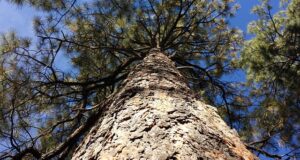CENTRAL SIERRA – Four years of drought have put tremendous stress on trees in California’s forests, resulting in widespread mortality.
While bark beetles are the primary cause of mortality for most pine and fir trees, other trees such as incense cedar and live oak are simply dying from lack of water. Extensive tree mortality is occurring in many areas across federal, state and private lands.
The drought is most severe in the southern half of the state, but drought conditions in the northern half of the state continue to intensify.
What to expect this summer:
The United States Department of Agriculture (USDA) Forest Service says extreme drought will put additional pressure on already stressed trees, leading to new and expanding mortality. Bark beetle populations will continue to increase, expanding and intensifying in current outbreak areas and reaching outbreak levels in new areas.
While drought may impact most trees, expect some of the greatest impacts on ponderosa, Jeffrey, lodgepole and sugar pines, as well as white fir and incense cedar.
So what you can do to protect your trees?
Improve tree growing conditions – this is typically accomplished through selective tree removal (thinning) to reduce inter-tree competition for limited water and nutrients. The best time to thin is during non-drought periods.
Inspect your trees – know what tree species you have and identify individuals that are most susceptible to drought and bark beetles; look for signs and symptoms of attack such as pitch tubes (globs of resin) and boring dust (sawdust) on the trunk. Also identify trees for removal that may be hazardous to life or property.
Protect high-value trees – Extreme drought conditions in many areas of the state have necessitated that landowners and managers consider ways to protect individual trees in high-use and residential settings. Individual tree treatments such as preventive spraying with insecticides, the use of synthetic products that repel bark beetles, supplemental watering and prompt removal/disposal of infested trees may all be effective depending on the situation and the tree species at risk. It is important to consult with a forest health specialist to determine the best treatments for your trees as there are several factors to consider and pros and cons to every treatment.
Individual Tree Protection Treatments
Avoiding ineffective and unproven treatments will save time, money and trees. Past drought and bark beetle-caused tree mortality events in California have spurred numerous claims of treatments that protect individual trees from bark beetles.
Treatments such as applying worm castings to the trunk, spraying insecticides into bark beetle entrance holes or applying acephate via an encapsulated implant have no scientific support for being effective, says the USDA. Systemic insecticides have shown some promise in limited situations, but they have not proven effective for protecting most conifer species from bark beetle attack. Land owners are advised to consult with a forest health specialist before taking any action.
Preventive spraying with certain insecticides has a proven track record for preventing successful bark beetle attack. This type of treatment is most appropriate for protecting pines but can be effective for other trees.
Many insecticides used against bark beetles must be applied by a licensed applicator. Insecticides must be applied before trees are infested with beetles. Post-infestation treatments will NOT save your trees. More information is available at http://www.fs.usda.gov/Internet/FSE_DOCUMENTS/stelprd3839478.pdf
Pheromone repellents have limited applicability. Repellants are available for protecting trees such as lodgepole pine and sugar pine from attacks by mountain pine beetles, and for protecting Douglas-fir from attacks by Douglas-fir beetles. Effective pheromone repellants have not yet been developed for other tree and bark beetle combinations. Please refer to the California Department of Pesticide Regulation website for current product registration at http://www.cdpr.ca.gov/docs/label/labelque.htm
Supplemental watering can reduce moisture stress for trees and potentially increase their resistance to bark beetle attacks. Deep watering (a couple of times per month during late spring/early summer) that is focused at the edge of the tree canopy will be most effective.
Avoid prolonged and excessive soil moisture around trees during the summer months, as this can lead to other tree health problems. The use of water-efficient irrigation tools such as deep tree watering stakes or root irrigators are highly recommended. Be sure to comply with any local water restrictions.
Removing bark beetle infested trees has shown to be effective in some situations. Prompt removal of infested trees may prevent neighboring trees from being attacked. Trees must be removed before beetles leave the tree to be effective. Bark beetles typically leave a tree about the time needles begin to fade from green to yellow. Bark beetles are no longer in the tree once needles have faded to an orange/red color.
Infested tree removal is most effective for Jeffrey pine and lodgepole pine. This treatment is less effective for infested ponderosa pine and white fir.
More detailed information, including photos of beetles and ways to identify trees, can be found here:
“Bark Beetles in California Conifers; Are Your Trees Susceptible?” at http://www.fs.usda.gov/Internet/FSE_DOCUMENTS/stelprdb5384837.pdf
or “Managing Bark Beetles in Urban and Rural Trees” at http://calfire.ca.gov/foreststeward/pdf/treenote19.pdf
For assistance, please contact:
US Forest Service (for Federal lands)
Northeastern California, Danny Cluck 530.252.6431
Southern Sierra, Beverly Bulaon 209.532.3671 x323
Northern California, Cynthia Snyder 530.226.2437
Southern California, Tom Coleman 909.382.2871
Regional Office, Sheri Smith 530.252.6667
CAL FIRE (for State and Private lands)
Cascade and Northern Sierra, Don Owen 530. 224.2494
Central and Southern Sierra, Tom Smith 916.599.6882
North Coast, Chris Lee 707.726.1254
South Coast and Southern California, Kim Corella 805.550.8583
Source: reprinted from http://www.fs.usda.gov/Internet/FSE_DOCUMENTS/stelprd3839507.pdf



